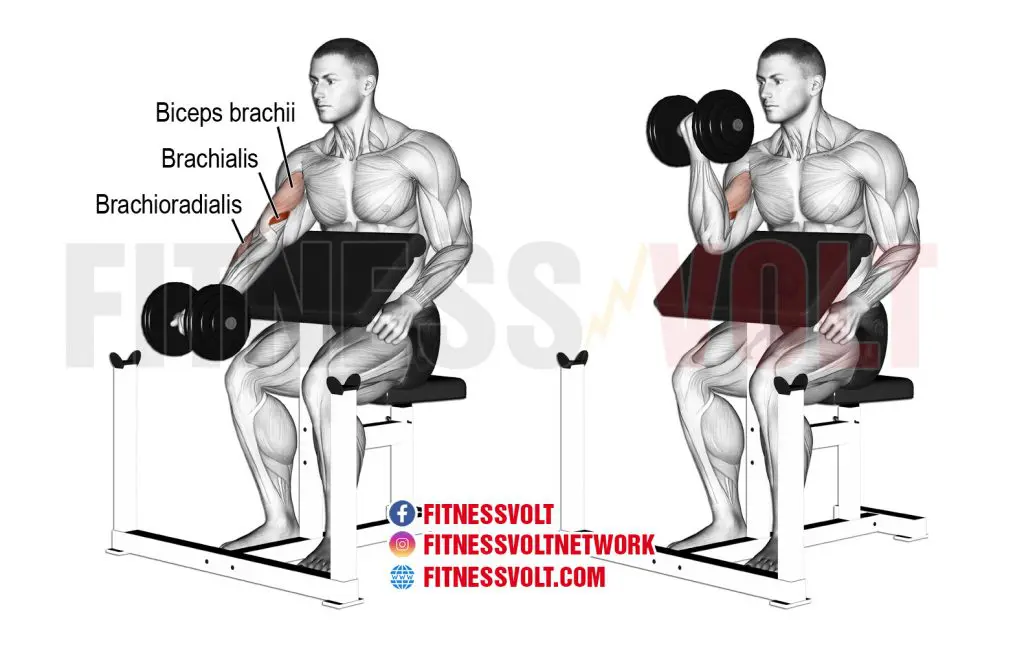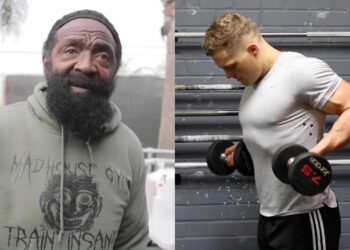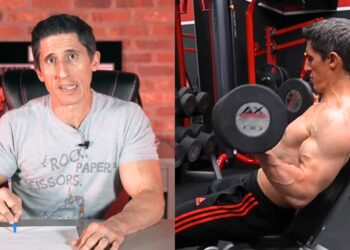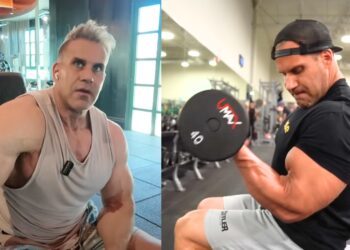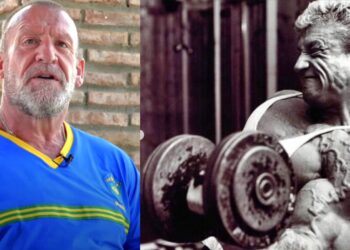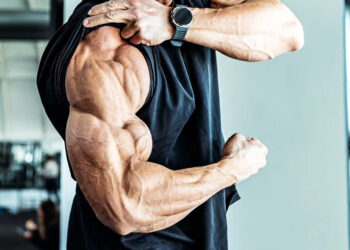While you can build a decent level of arm strength and size with exercises like pulldowns, pull-ups, and rows, if you are serious about filling out your shirtsleeves, you need to include biceps curls in your workouts.
However, to get the best possible results, you should use a variety of curling exercises in your workouts. That’s not to say regular barbell or dumbbell biceps curls are no good; it’s just that exercise variety will help you make faster progress.
Here are 11 biceps curl variations to try.
Types of Bicep Curls (Barbell and Dumbbell Variations)
1. Seated barbell curl
Barbell curls are normally done standing. This barbell curl variation is done seated, which stops you from using your legs and back to lift the bar. Also, each rep starts from a dead stop. This is much more challenging and a great way to build muscle size, strength, and power.
How to do it:
- Sit on an exercise bench with the backrest set to 90 degrees.
- Rest a barbell across your thighs and hold it with a shoulder-width, underhand grip.
- Without moving your body away from the backrest, curl the bar up to your shoulders.
- Pause at the top of the rep for a second and then lower the bar back to your thighs.
2. Iso-lateral dumbbell curl
Iso-lateral dumbbell curls involve working one arm at a time in an alternating fashion. However, unlike regular alternating curls, your non-working arm doesn’t get to rest between reps. This exercise increases your time under tension, which is an essential factor for muscle hypertrophy or growth. Time under tension is the length of time your muscles spend working per set.
Level Up Your Fitness: Join our 💪 strong community in Fitness Volt Newsletter. Get daily inspiration, expert-backed workouts, nutrition tips, the latest in strength sports, and the support you need to reach your goals. Subscribe for free!
How to do it:
- Sit or stand with a dumbbell in each hand.
- Curl the weights up to your shoulders and hold them there. This is your starting position.
- Keeping your left arm stationary, lower the right-hand weight down to your side and then curl it back up to your shoulder.
- Next, keeping your right arm stationary, lower the left-hand weight down to your side, and then curl it back up to your shoulder.
- That’s one rep; continue for the duration of your set.
3. 21s
21s, also known as the matrix system, breaks a standard rep down into three distinct ranges of motion – inner, outer, and full. Doing these ranges of motion separately eliminates momentum and also creates a huge muscle-building pump. Don’t underestimate this exercise; it’s much tougher than it looks!
How to do it:
- Sit or stand with a dumbbell in each hand, arms by your sides.
- Bend your arms and curl the weight up until your forearms are perpendicular to the floor. Lower your dumbbells and repeat seven times.
- Next, and starting with your arms bent to 90 degrees, curl your weights up to your shoulders seven times. Do not lower the weights down past half-way.
- Finally, do seven full-range reps.
- You can also do this biceps curl variation with a barbell, cable, or machine.
4. Hammer curl
Hammer curls don’t just work your biceps, they also work your brachioradialis. This secondary arm muscle sits beneath and below your biceps. Building it up will add size to your upper and lower arm.
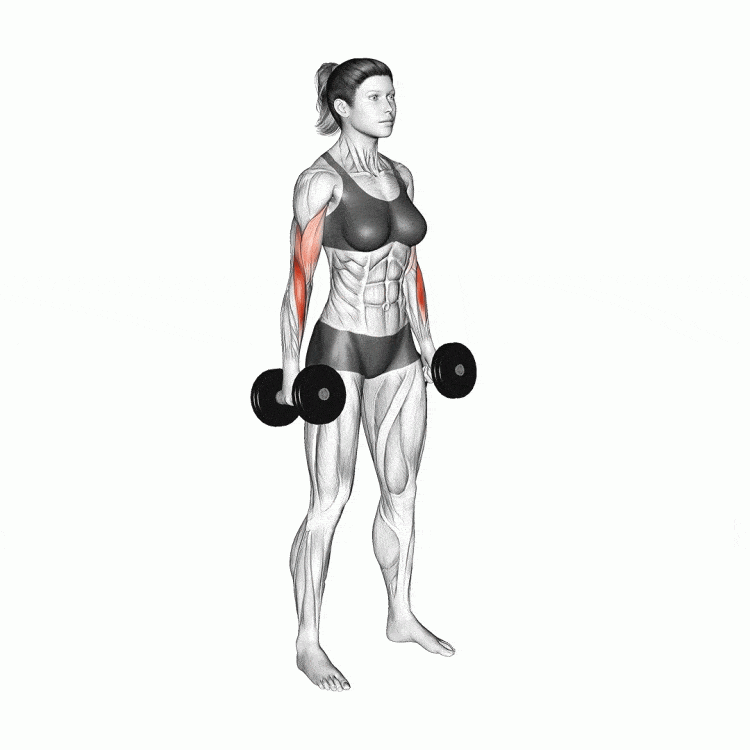
How to do it:
- Hold a dumbbell in each hand, with your arms by your sides. Turn your palms in toward your thighs.
- Bend your arms and curl the weights up to your shoulders. Do not rotate your wrists but, instead, keep your thumbs uppermost.
- Lower the weights back to your sides and repeat.
- Curl both dumbbells at the same time or use an alternating arm action as preferred.
5. Power curl
To the uninitiated, power curls look like you are cheating. However, the reality is they are more like an underhand power clean and allow you to expose your muscles to much more muscle-building tension and stress than other types of curl. This is an advanced exercise, so only try it if you have been training consistently for a year or more.
How to do it:
- Hold a barbell with an underhand, shoulder-width grip.
- Bend your knees slightly, lean forward from your hips, and lower the bar down to the middle of your thighs.
- Drive your hips forward, stand up explosively, and use this momentum to help you curl the weight up to your shoulders.
- Brace your abs, tuck your upper arms into your sides and then lower the weight slowly and smoothly back down.
- You can also do this exercise with dumbbells.
6. Reverse curl
Reverse curls work your biceps and forearms at the same time. Big biceps look better when combined with muscular forearms. This exercise saves you time by training these muscles together.
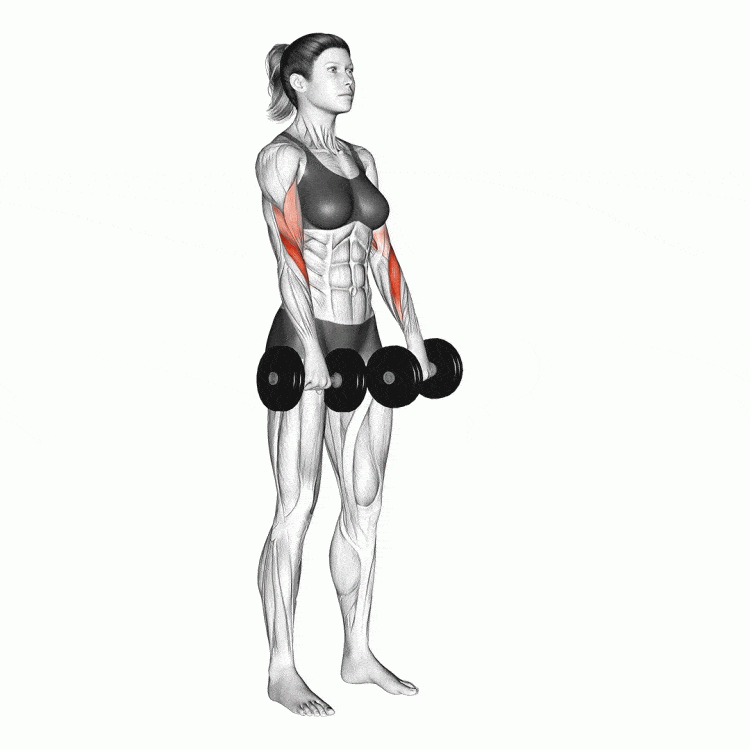
How to do it:
- Hold a barbell with a shoulder-width, overhand grip. Place your thumbs on top of the bar and not under it to make the exercise harder.
- Brace your abs, tuck your elbows into your sides and bend your arms. Curl the weight up to your shoulders and then lower it again. Keep your wrists straight throughout.
- Make this exercise even more challenging by using a thick barbell. The thicker the bar, the more difficult it is to grip, and the harder you’ll have to work.
7. Preacher cable curl
Preacher curls are very popular, but they are also a flawed exercise. They are hardest when your arms are extended, but the weight all but vanishes as your elbows approach 90 degrees (1). Using cables means that your biceps are under constant tension, and that’s much better for muscle building.
How to do it:
Level Up Your Fitness: Join our 💪 strong community in Fitness Volt Newsletter. Get daily inspiration, expert-backed workouts, nutrition tips, the latest in strength sports, and the support you need to reach your goals. Subscribe for free!
- Place a preacher curl bench in front of a low pulley machine fitted with a straight or EZ bar.
- Grab the bar with an underhand grip and place your upper arms against the angled surface of the bench.
- Starting with your arms straight, bend your elbows and curl the handle up to your face. Hold the top of your rep before slowly lowering the weight and repeating.
- You can also do this exercise using one arm at a time. Simply replace the straight bar with a single D-shaped handle.
8. Kettlebell biceps curl
Kettlebells aren’t usually associated with biceps training, but that doesn’t mean you can’t use them to build arm strength and size. This exercise is not only good for your biceps, but it will also help develop your forearms and strengthen your grip too.
How to do it:
- Grab a kettlebell by the top of the handle and hold it down by your side. Grip the handle tightly. Your palm should be turned in toward your leg.
- Bend your arm and curl the weight forward and up. Do not allow your wrists to bend.
- Lower the weights and repeat.
9. Jettison barbell curl
Jettison barbell curls offer a unique twist on drop sets. With drop sets, you reduce the weight you are using as you get tired, which allows you to do more reps than usual. This biceps curl variation achieves the same goal, but by combining a resistance band with a barbell.
How to do it:
- Use a resistance band with a handle at each end.
- Take a handle in each hand and then also pick up and hold a barbell with an underhand, shoulder-width grip. Stand on the center of the band to tension it.
- Next, rep out with the bar and band until you are unable to continue.
- Release (jettison) the band and keep curling the weight. Do as many reps as you can.
- Finally, put the weight down, pick up the band, and pump out a few more reps until you are unable to continue.
10. Chin-up
Chin-ups are usually thought of as a back exercise but, if you look at the arm and elbow action, you can see it’s also a biceps curl exercise. However, instead of curling a bar up to your shoulders, when you do chin-ups, you curl your shoulders up to the bar.
How to do it:
- Reach up and grip an overhead bar with an underhand, shoulder-width grip. Hang down so your feet are clear of the floor, and your arms are straight.
- Without kicking your legs, bend your arms and pull your chin up and over the bar.
- Lower yourself back down to full arm extension and repeat.
- If you can do ten or more reps, strap on some extra weight to make this exercise more challenging. Start with about 10% of your body weight.
11. Drag Curl
This variation strengthens your biceps and promotes hypertrophy. Drag curls will emphasize the brachialis, biceps brachii, and elbow flexors. You can use the EZ bar or barbell palms facing upward (supinated) with a shoulder-width grip. As compared to other biceps exercises this variation uses a short range of motion.
One benefit for drag curl is that it prevents the involvement of the front deltoids when you lift so the focus is solely on biceps. Use less weight than traditional curl with controlled tempo so make sure to leave your ego outside the door.
Defining a “Bicep Curl Variation”
Understanding the biomechanics of an exercise is crucial in determining whether it qualifies as a bicep curl variation. Simply isolating the biceps isn’t sufficient. For an exercise to be categorized as a bicep curl variation, its movement should primarily involve:
Elbow Flexion: When the exercise engages elbow flexion and the biceps brachii becomes the main muscle activated, it is likely a bicep curl variation. This definition accommodates different curl types, since not all variations necessitate a supinated grip. For instance, both reverse curls and hammer curls don’t use a supinated hand position, yet they remain integral in biceps training.
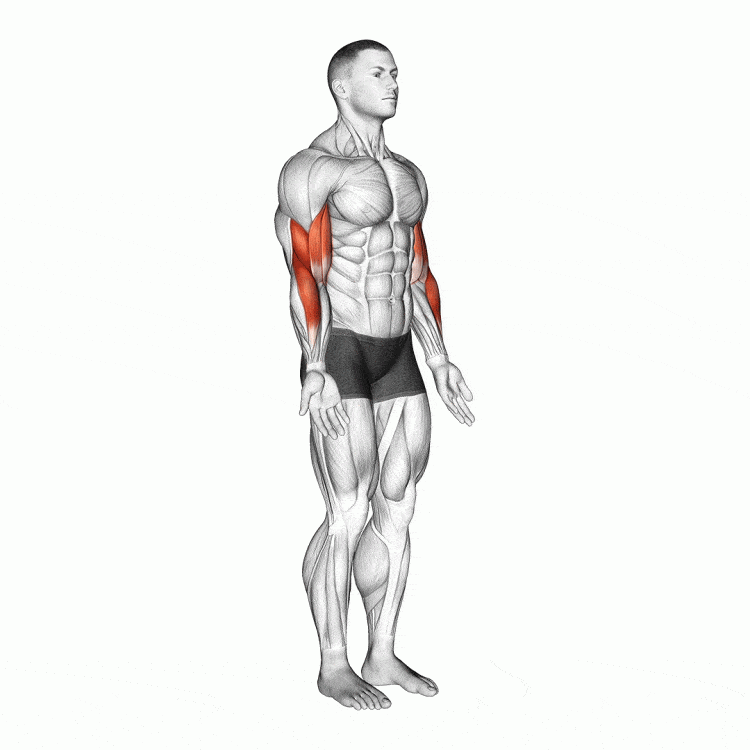
Choosing the Optimal Bicep Curl Variation
When incorporating a bicep curl into a workout regime, consider the following:
1. Muscular Recruitment
While most bicep curl variations will substantially engage the biceps, they don’t exclusively target them. Some might also activate neighboring muscles such as the brachioradialis, brachialis, some forearm muscles, or even the deltoids. Therefore, understanding the muscle groups each exercise engages is crucial when curating a balanced training routine.
2. Intensity
It’s not just about fitting the bicep curl variation into your routine; it’s about the exercise’s intensity. Does it adequately stimulate the biceps? Lifters who don’t have other biceps-targeted exercises might opt for a more intense variation that extensively recruits the biceps. Conversely, routines with multiple bicep-focused exercises might not need additional bicep curl variations.
In conclusion, the right choice of bicep curl variations depends on the specific goals and composition of one’s workout regimen. The key is to ensure optimal and balanced muscle engagement.
Wrap up
A lot of exercisers are frustrated by their lack of arm size; don’t be one of them! Use these biceps curl variations to keep your arm training fresh, fun, and productive. Standard barbell and dumbbell curls are fine for beginners but, once you’ve become accustomed to these exercises, you’ll need to move beyond them to maximize your arm growth.
Also read:
References:
1. PubMed: Oliveira, Liliam F.; Matta, Thiago T.; Alves, Daniel S.; Garcia, Marco A. C.; Vieira, Taian M. M. (2009). “Effect of the shoulder position on the biceps brachii emg in different dumbbell curls”. Journal of Sports Science & Medicine. 8 (1): 24–29. ISSN 1303-2968. PMC 3737788. PMID 24150552. https://www.ncbi.nlm.nih.gov/pubmed/24150552

